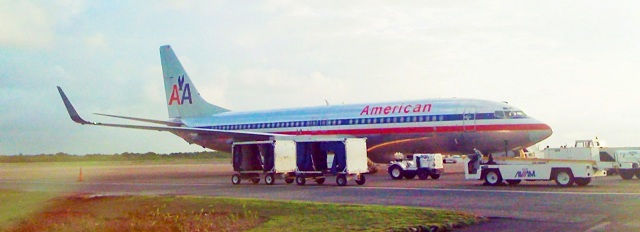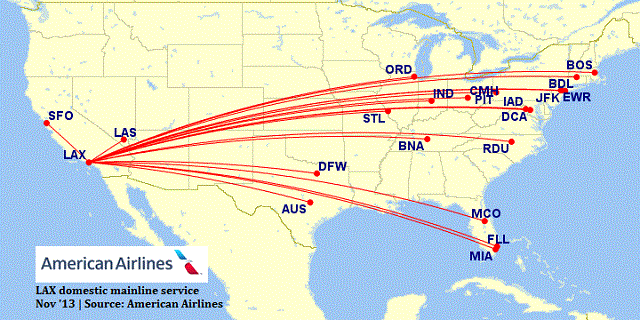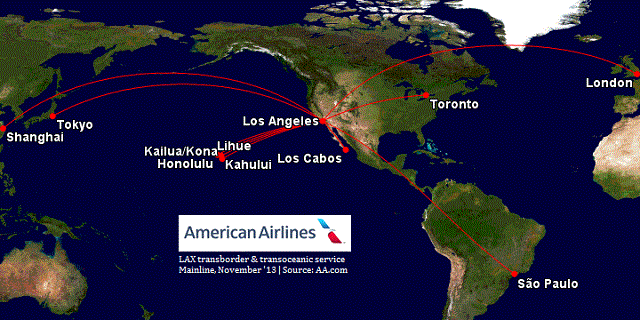
LA is hot these days! In its latest push for greater marketshare dominance in one of its five “cornerstone” hubs, last week American Airlines announced big expansion plans from LAX, linking Southern California with nonstop service to several mid-tier markets across the country beginning this August.
The announcement, published on American’s Newsroom page, comes several weeks after the carrier also stated its intentions to launch nonstop service from LAX to São Paulo, Brasil this November.
Beginning August 27th, American will fly nonstop from LAX to Pittsburgh, PA, Indianapolis, IN, Columbus, OH, Hartford, CT, Fayetteville, AR, Eugene, OR and Redmond, WA. Once these cities go-live, American will serve a total of 51 destinations from its LAX “hub.”



The expansion underscores American’s commitment to LAX as a cornerstone hub, in addition to its four other “cornerstone hubs” at Dallas/Ft. Worth, Chicago O’Hare, Miami and New York JFK airports. American adopted the cornerstone hub strategy in 2009 by concentrating 98% of its network around scheduling flights originating and terminating at one of these five cities.
Since implementing the cornerstone hub plan, American has added service from LAX to destinations such as Fort Lauderdale, El Paso, Houston, Santa Fe and Shanghai, among others. It is believed that after reorganizing in bankruptcy, American has a more competitive cost structure to enable launching longer-range routes and strengthening its position at LAX.
Relative to the other cornerstone hubs, however, LAX presents the most unique dilemma of being highly fragmented among major US carriers. United Airlines is the #1 carrier at LAX in terms of capacity share (by percentage of seats) holding 20.1% as of April 15, 2013, according to flight timetables. American comes in at #2 with 19.8% of the marketshare, and Delta follows at #3 with 14.2%. Southwest, Virgin America and Alaska also hold significant market share presences at LAX as well.
Without question, it seems like everyone wants to grab a slice of the pie at LAX. Delta, in particular, has been very aggressive in adding services at LAX, going after cutthroat markets like LA-Seattle and LA-Nashville, both of which have plenty of low-cost carrier presences via Alaska, Southwest and Virgin America, which creates significant fare pressure.
Interestingly, Delta has previously experimented with medium-range mid/trans-continental routes, mirroring AA’s current plans, by adding Los Angeles to Indianapolis, Raleigh/Durham, Columbus, Philadelphia, Tampa and Hartford over the years, with mixed results. Philadelphia and Hartford were ultimately pulled, and Columbus reduced to a thrice-weekly seasonal operation. Indianapolis is served thrice weekly and Raleigh/Durham is six weekly. American commenced nonstop service between LA and RDU on April 2 with daily service, and intends to fly daily to Indianapolis and Columbus as well, hoping to attract higher-yielding traffic with more scheduling options.
Returning to the new AA flights, it is interesting that American is essentially targeting city pairs from LAX which currently have only one carrier currently serving the route. Such is the case for LAX-PIT, flown solely by United, and LAX-IND/CMH, served strictly by Delta. Fayetteville and Eugene are presently served by ultra-low cost leisure carrier Allegiant Air, which offers low-frequency service and appeals to a separate type of budget traveler. American will hold a monopoly on the Redmond and Hartford flights, the latter which was once served by AA pre-9/11.
The general vibes on airline chat forums seem to be optimistic about the potential successes of the new routes. LA is a huge local market in and of itself, and LAX has the advantage of catering to multiple AA OneWorld partners such as British Airways, airberlin, Japan Airlines, LAN, Cathay Pacific, Qantas and Malaysian Airlines, providing feed on domestic and international connections.
Moreover, the LAX additions sheds some light on the impact of the impending American-US Airways merger, another topic I have written about extensively. US Airways has a hub at Phoenix Sky Harbor International Airport, located a stone throw’s away from LAX. US currently flies from PHX to Indianapolis, Columbus and Pittsburgh, which could be considered extraneous moving forward. In general, the current size and scale of the Phoenix hub is perceived to be in question once the merger is complete.

